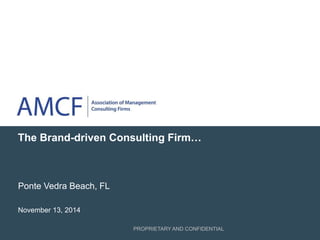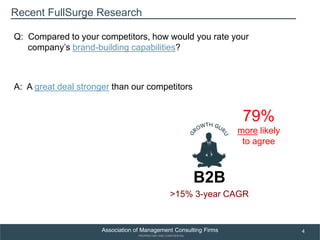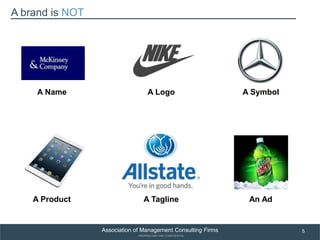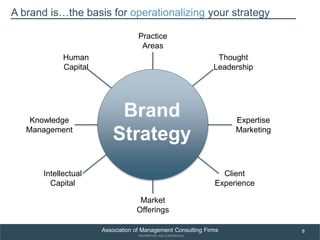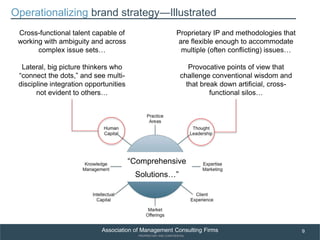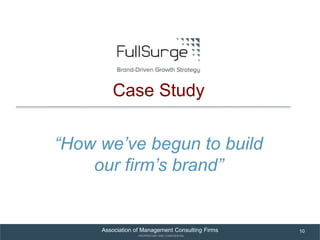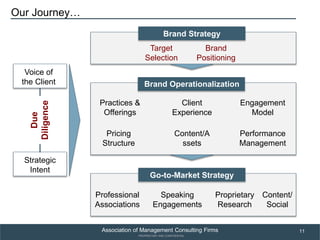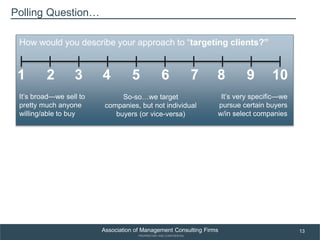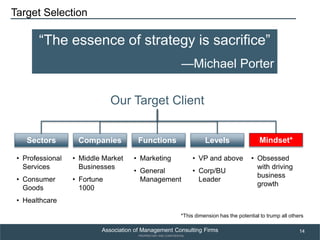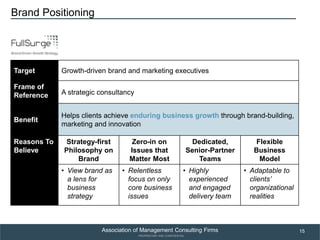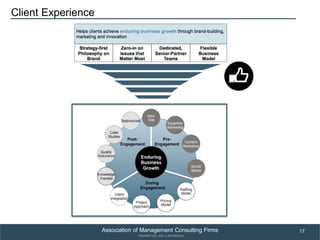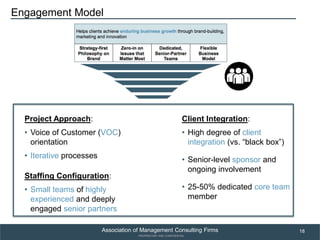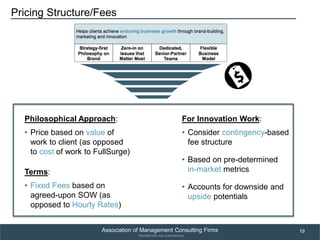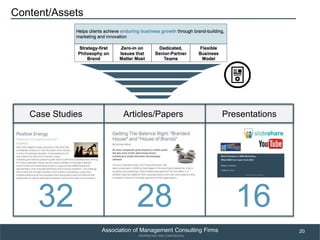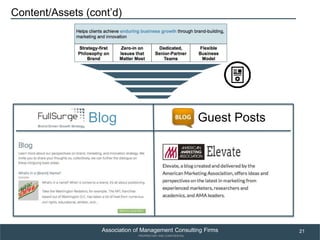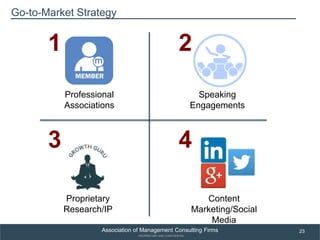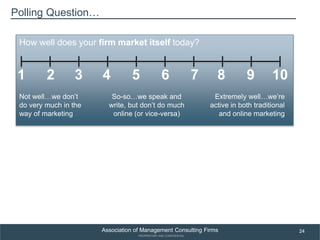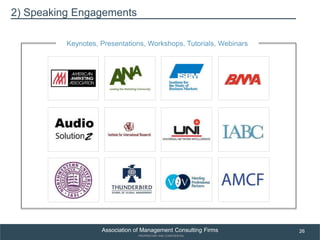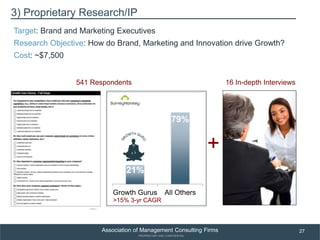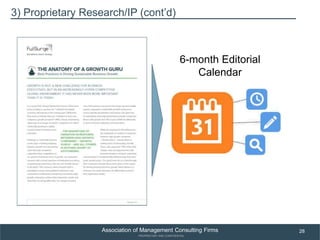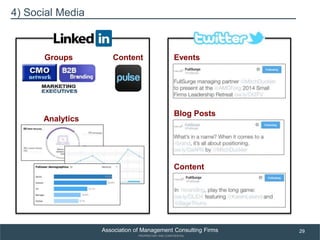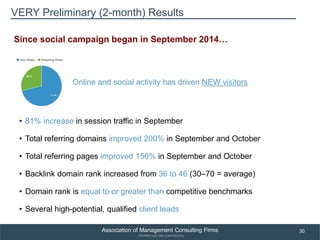Building a Brand-driven Consulting Firm
- 5. ŌĆ”ŌČ─”
- 12. ŌĆ”
- 22. ŌĆ” ŌĆ”ŌČ─”
Editor's Notes
- #3: Earlier this year my firm, FullSurge, fielded a proprietary quantitate research study Our goal was to understand what high-growth companies do differently from a brand, marketing and innovation perspective, than everyone else Secondarily, we wanted to understand how B2B companies compared to B2C on these measures ~20% of sample ŌĆ” deemed Growth Gurus
- #4: Earlier this year my firm, FullSurge, fielded a proprietary quantitate research study Our goal was to understand what high-growth companies do differently from a brand, marketing and innovation perspective, than everyone else Secondarily, we wanted to understand how B2B companies compared to B2C on these measures ~20% of sample ŌĆ” deemed Growth Gurus
- #5: Earlier this year my firm, FullSurge, fielded a proprietary quantitate research study Our goal was to understand what high-growth companies do differently from a brand, marketing and innovation perspective, than everyone else Secondarily, we wanted to understand how B2B companies compared to B2C on these measures ~20% of sample ŌĆ” deemed Growth Gurus
- #6: Earlier this year my firm, FullSurge, fielded a proprietary quantitate research study Our goal was to understand what high-growth companies do differently from a brand, marketing and innovation perspective, than everyone else Secondarily, we wanted to understand how B2B companies compared to B2C on these measures ~20% of sample ŌĆ” deemed Growth Gurus
- #7: Earlier this year my firm, FullSurge, fielded a proprietary quantitate research study Our goal was to understand what high-growth companies do differently from a brand, marketing and innovation perspective, than everyone else Secondarily, we wanted to understand how B2B companies compared to B2C on these measures ~20% of sample ŌĆ” deemed Growth Gurus
- #8: Earlier this year my firm, FullSurge, fielded a proprietary quantitate research study Our goal was to understand what high-growth companies do differently from a brand, marketing and innovation perspective, than everyone else Secondarily, we wanted to understand how B2B companies compared to B2C on these measures ~20% of sample ŌĆ” deemed Growth Gurus
- #9: Earlier this year my firm, FullSurge, fielded a proprietary quantitate research study Our goal was to understand what high-growth companies do differently from a brand, marketing and innovation perspective, than everyone else Secondarily, we wanted to understand how B2B companies compared to B2C on these measures ~20% of sample ŌĆ” deemed Growth Gurus
- #10: Earlier this year my firm, FullSurge, fielded a proprietary quantitate research study Our goal was to understand what high-growth companies do differently from a brand, marketing and innovation perspective, than everyone else Secondarily, we wanted to understand how B2B companies compared to B2C on these measures ~20% of sample ŌĆ” deemed Growth Gurus
- #12: Earlier this year my firm, FullSurge, fielded a proprietary quantitate research study Our goal was to understand what high-growth companies do differently from a brand, marketing and innovation perspective, than everyone else Secondarily, we wanted to understand how B2B companies compared to B2C on these measures ~20% of sample ŌĆ” deemed Growth Gurus
- #13: Earlier this year my firm, FullSurge, fielded a proprietary quantitate research study Our goal was to understand what high-growth companies do differently from a brand, marketing and innovation perspective, than everyone else Secondarily, we wanted to understand how B2B companies compared to B2C on these measures ~20% of sample ŌĆ” deemed Growth Gurus
- #14: Earlier this year my firm, FullSurge, fielded a proprietary quantitate research study Our goal was to understand what high-growth companies do differently from a brand, marketing and innovation perspective, than everyone else Secondarily, we wanted to understand how B2B companies compared to B2C on these measures ~20% of sample ŌĆ” deemed Growth Gurus
- #15: Earlier this year my firm, FullSurge, fielded a proprietary quantitate research study Our goal was to understand what high-growth companies do differently from a brand, marketing and innovation perspective, than everyone else Secondarily, we wanted to understand how B2B companies compared to B2C on these measures ~20% of sample ŌĆ” deemed Growth Gurus
- #16: Earlier this year my firm, FullSurge, fielded a proprietary quantitate research study Our goal was to understand what high-growth companies do differently from a brand, marketing and innovation perspective, than everyone else Secondarily, we wanted to understand how B2B companies compared to B2C on these measures ~20% of sample ŌĆ” deemed Growth Gurus
- #17: Earlier this year my firm, FullSurge, fielded a proprietary quantitate research study Our goal was to understand what high-growth companies do differently from a brand, marketing and innovation perspective, than everyone else Secondarily, we wanted to understand how B2B companies compared to B2C on these measures ~20% of sample ŌĆ” deemed Growth Gurus
- #18: Earlier this year my firm, FullSurge, fielded a proprietary quantitate research study Our goal was to understand what high-growth companies do differently from a brand, marketing and innovation perspective, than everyone else Secondarily, we wanted to understand how B2B companies compared to B2C on these measures ~20% of sample ŌĆ” deemed Growth Gurus
- #19: Earlier this year my firm, FullSurge, fielded a proprietary quantitate research study Our goal was to understand what high-growth companies do differently from a brand, marketing and innovation perspective, than everyone else Secondarily, we wanted to understand how B2B companies compared to B2C on these measures ~20% of sample ŌĆ” deemed Growth Gurus
- #20: Earlier this year my firm, FullSurge, fielded a proprietary quantitate research study Our goal was to understand what high-growth companies do differently from a brand, marketing and innovation perspective, than everyone else Secondarily, we wanted to understand how B2B companies compared to B2C on these measures ~20% of sample ŌĆ” deemed Growth Gurus
- #21: So, with over 15+ years working with B2B companies ŌĆ” and with these research results as validation We have distilled what B2B Growth Gurus do different and better from a Marketing perspective Whether on their own or with our helpŌĆ” Here are five things they do better than ŌĆ£otherŌĆØ B2B marketers [READ THEM 1 BY 1]
- #22: So, with over 15+ years working with B2B companies ŌĆ” and with these research results as validation We have distilled what B2B Growth Gurus do different and better from a Marketing perspective Whether on their own or with our helpŌĆ” Here are five things they do better than ŌĆ£otherŌĆØ B2B marketers [READ THEM 1 BY 1]
- #23: Earlier this year my firm, FullSurge, fielded a proprietary quantitate research study Our goal was to understand what high-growth companies do differently from a brand, marketing and innovation perspective, than everyone else Secondarily, we wanted to understand how B2B companies compared to B2C on these measures ~20% of sample ŌĆ” deemed Growth Gurus
- #24: So, with over 15+ years working with B2B companies ŌĆ” and with these research results as validation We have distilled what B2B Growth Gurus do different and better from a Marketing perspective Whether on their own or with our helpŌĆ” Here are five things they do better than ŌĆ£otherŌĆØ B2B marketers [READ THEM 1 BY 1]
- #25: Earlier this year my firm, FullSurge, fielded a proprietary quantitate research study Our goal was to understand what high-growth companies do differently from a brand, marketing and innovation perspective, than everyone else Secondarily, we wanted to understand how B2B companies compared to B2C on these measures ~20% of sample ŌĆ” deemed Growth Gurus
- #26: So, with over 15+ years working with B2B companies ŌĆ” and with these research results as validation We have distilled what B2B Growth Gurus do different and better from a Marketing perspective Whether on their own or with our helpŌĆ” Here are five things they do better than ŌĆ£otherŌĆØ B2B marketers [READ THEM 1 BY 1]
- #27: So, with over 15+ years working with B2B companies ŌĆ” and with these research results as validation We have distilled what B2B Growth Gurus do different and better from a Marketing perspective Whether on their own or with our helpŌĆ” Here are five things they do better than ŌĆ£otherŌĆØ B2B marketers [READ THEM 1 BY 1]
- #28: So, with over 15+ years working with B2B companies ŌĆ” and with these research results as validation We have distilled what B2B Growth Gurus do different and better from a Marketing perspective Whether on their own or with our helpŌĆ” Here are five things they do better than ŌĆ£otherŌĆØ B2B marketers [READ THEM 1 BY 1]
- #29: So, with over 15+ years working with B2B companies ŌĆ” and with these research results as validation We have distilled what B2B Growth Gurus do different and better from a Marketing perspective Whether on their own or with our helpŌĆ” Here are five things they do better than ŌĆ£otherŌĆØ B2B marketers [READ THEM 1 BY 1]
- #30: So, with over 15+ years working with B2B companies ŌĆ” and with these research results as validation We have distilled what B2B Growth Gurus do different and better from a Marketing perspective Whether on their own or with our helpŌĆ” Here are five things they do better than ŌĆ£otherŌĆØ B2B marketers [READ THEM 1 BY 1]
- #31: So, with over 15+ years working with B2B companies ŌĆ” and with these research results as validation We have distilled what B2B Growth Gurus do different and better from a Marketing perspective Whether on their own or with our helpŌĆ” Here are five things they do better than ŌĆ£otherŌĆØ B2B marketers [READ THEM 1 BY 1]
- #32: So, with over 15+ years working with B2B companies ŌĆ” and with these research results as validation We have distilled what B2B Growth Gurus do different and better from a Marketing perspective Whether on their own or with our helpŌĆ” Here are five things they do better than ŌĆ£otherŌĆØ B2B marketers [READ THEM 1 BY 1]

